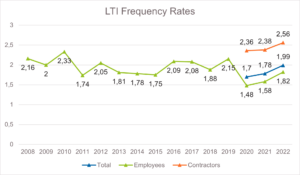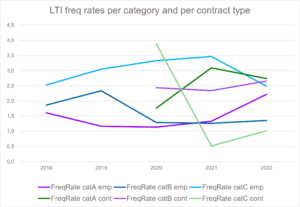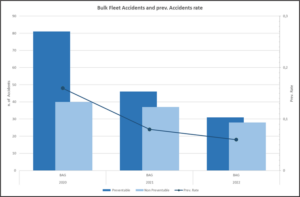EIGAzette 2023 05 – SAC
1 Introduction: Safety Performance Review
1.1 Fatalities reported in 2022
During 2022 4 fatalities occurred among contractors, 2 on the road and 2 at customer’s site.
- February, Slovenia: A contract driver was driving an LPG rigid tanker and left the road and rolled over down a slope. The driver died due to the impact. The truck was full of 7 ton of LPG, no leak occurred.
- May, Austria: Contractor driver in a van on highway crashed into the last car of a traffic jam and died.
- November, Germany: Whilst unloading a vessel from a truck, the crane operator standing on a ladder used the remote control to attach the lifting chains on the vessel. He was crunched between the crane arm and the vessel and died.
- November, Taiwan: A contractor was working on a pipeline in a trench when the wall of the trench collapsed. The contractor died.
During 2022, another 20 fatalities have been recorded among third parties. All of them were a consequence of 18 road traffic accidents.
- January, South Africa: A third party passenger car was suddenly moving into the lane of our vehicle and collided head on with the truck. The third-party driver died.
- February, Spain: A pickup truck was driving in the centre of a three-lane road. A motorcyclist was driving in the left lane and changed lane due to a parked car. The motorcyclist collided with the left door of the truck. The motorcyclist died.
- February, Austria: Truck turned left and did not see an oncoming motorcyclist due to sun glare and hit the scooter. The person on the scooter died.
- February, UK: A person stepped out in front of the truck, got hit and died.
- April, Italy: A liquid helium trailer was stopped in a traffic jam. Another truck drove into the back of the helium trailer. The driver of this truck died.
- April, Slovakia: Whilst driving on a straight road the company truck wanted to avoid the impact with a car in front of him turning right. He moved to the left lane and had a head on collision with an oncoming car. The driver of the car died.
- June, Poland: Haulier driver was driving along roadway when a car from the opposite direction changed lane and had a head-on collision with the truck. The third-party passenger died.
- July, Brazil: A bulk driver was driving on a 2-lane way. Another car was driving next to the bulk tanker on the other lane. A motorcyclist overtook both vehicles in between them, hit the car, ended up under the bulk tanker and died.
- August, Austria: A third party car driver was changing lane on a curve on the road and had a head on collision with a liquid truck. The third-party driver died.
- August, France: A third party car driver was changing lane on a curve on the road and had a head on collision with a gas truck. The third-party driver died.
- May, Columbia: Motorcyclist made contact with cylinder vehicle, fell and died.
- May, Mexico: A third party driver of a pickup truck collided into the back of a gas vehicle and died.
- March, Brazil: The third party coming from the opposite direction made overtake on a corner and collided in the front of a trailer. Third party driver died.
- September, Brazil: Truck was stopped in non-driving area and was struck in the rear by a motorcyclist. The motorcyclist died.
- October, Turkey: (2 fatalities) Third party driver and passenger were killed when rear ending with excessive speed in the truck.
- October, Romania: A truck was driving during the night. A pedestrian crossed quickly over the zebra crossing, got hit and died.
- September, Switzerland: A cylinder truck was in a traffic jam in a city. A pedestrian was moving next to the truck and ended up under the vehicle. The pedestrian died.
- July, UK A: truck continued on a straight road at normal speed. A third-party car changed lane and had a head on collision with the truck. The third-party driver died.
Road transport continues to be the activity by which we in the gas industry and others interfacing with our equipment are most at risk of serious injury or fatality. Any improvement in telematics, cameras, coaching can only help reduce such events.
1.2 EIGA Safety Performance Lost Time Injuries
Considering the Los Time Incident Frequency Rate trend (for associated companies’ employees) reported in this annual report starting from 2008 it is possible to observe a slight continuous improvement in the safety performance of our Industry, bouncing year by year on the limit value of 2 incidents per one million of worked hours. The best value was reached in 2020 with a significant reduction of the value of 2.15 related to the previous year.


Fig.1: Numbers of Lost Time Injuries and LTI-Frequency Rate)
For employees, the gap between Category C companies and the rest is significatively reduced due to an inversion of the trend in the category C related to an increase of the values in category A companies. For Contractors the reduction of accidents is important for all categories.

Fig.2: LTI-Frequency Rate per category members
1.3 EIGA Safety Performance Recordable Injuries (data from WIST)
Recordables Injuries graph present a trend very similar to the trend observed for LTI (for employees). Absolute values are more than double compared to LTI for both (contractors and employees).


Fig.3: Numbers of Recordable Injuries and RWI-Frequency Rate

Fig.4: RWI-Frequency Rate per category members
1.4 EIGA Safety Performance Road accidents (data from RAST)
The bulk fleet statistic evidence a positive trend in absolutes numbers and in frequency rate (numbers related to km driven). For the Cylinders fleet the trend is favourable in terms of numbers, but we can observe a slight increase in the frequency rate (in 2022 Q3 double than Bulk).

Fig.5: Numbers of Accidents and prev. accidents Frequency Rate – Bulk Fleet (2022 Q3)

Fig.6: Numbers of Accidents and prev. accidents Frequency Rate – Cylinder Fleet (2022 Q3)
Since 2020 all member companies are obliged to report the fleet accidents in the RAST database. This allowed SAC to create statistical analysis of accidents occurred on the road.
2 Safety Advisory Council Activity Report
2.1 SAC Membership Changes in 2022
There have been no changes in the SAC Team in 2022.
In 2023, starting from meeting 175, the representatives of Air Liquide and Nippon Gases Europe will change from Susana Marques to Jérôme Garin and from Rainer Wysotzki to Darren Pick.
2.2 Key achievements in 2022
2.2.1 Publications
During 2022 a significant number of documents and other publications have been published or revised by SAC or by the WGs and AHGs under the supervision of SAC. These total 19 publications, including:
- 1 Briefing Note
- 4 Safety Information
- 1 Safety Leaflet
- 3 Training Packages – Recent Incidents
- 2 Technical Bulletin
- 8 Documents
2.2.2 Learning from Incidents
In 2022 SAC created 4 Training Packages on recent incidents in industrial and medical gases industry. Each event reported in these Training Packages is discussed within SAC to identify root causes and current best practices that could have helped to avoid negative outcomes.
The results of this discussion are included in the documents under the paragraph ‘discussion points’. A special attention is paid to report “Safety II” events.
2.3 Working Groups and Ad-Hoc Groups
A new Ad-Hoc Groups was created in 2022.
- AHG 16.1 to review Seveso doc 60
In 2023 an Ad-Hoc Group was created to manage the PFAS ban proposal European Chemicals Agency (ECHA)
- AHG S.15 PFAS restriction
There is an ongoing discussion to convert the following Ad-Hoc Groups to a permanent WG:
- AHG-S.2 (Process Safety) – To present IGC the decision of SAC 175